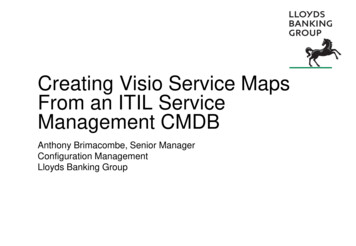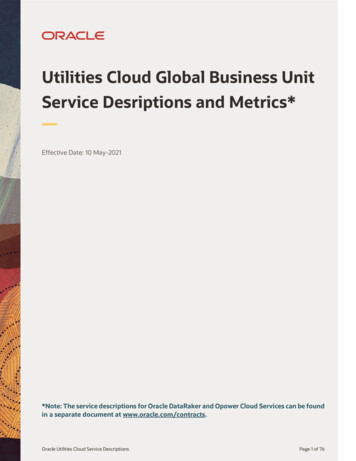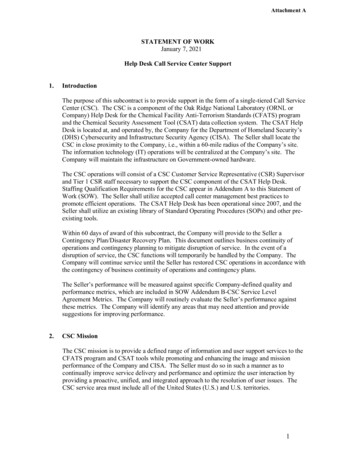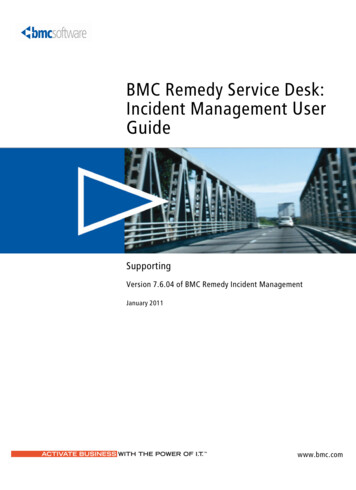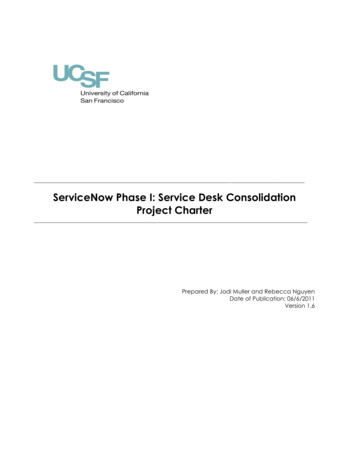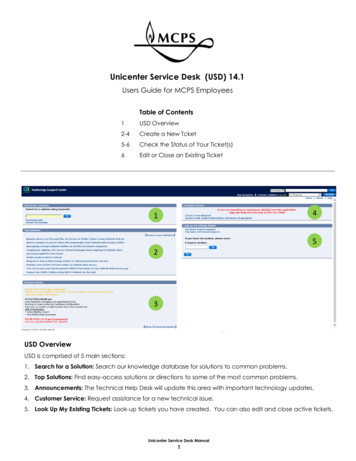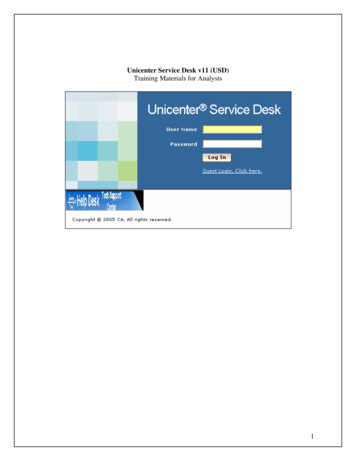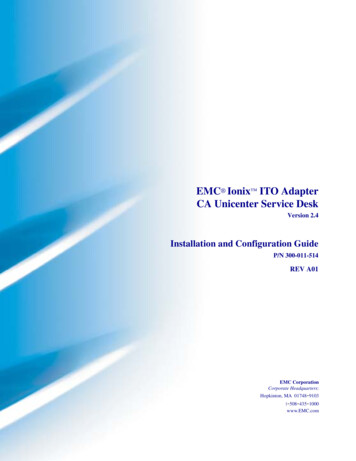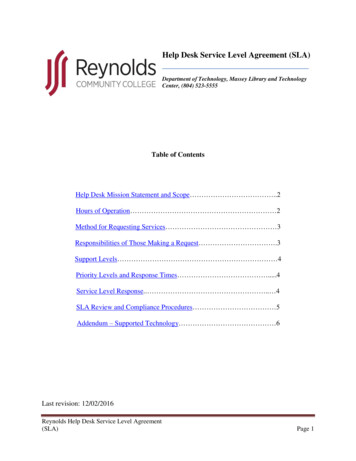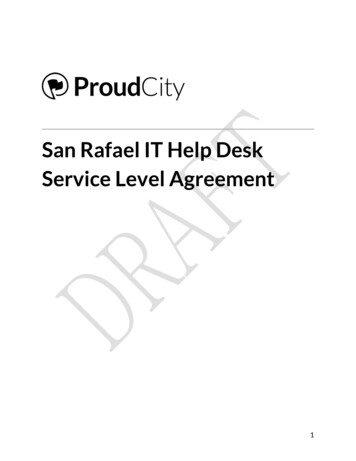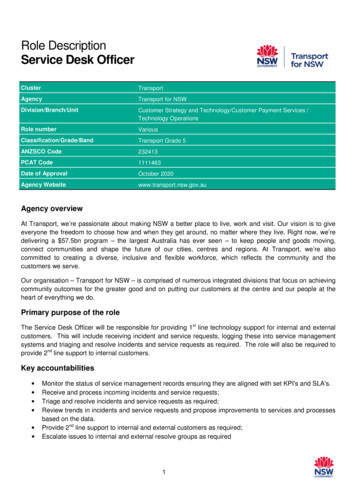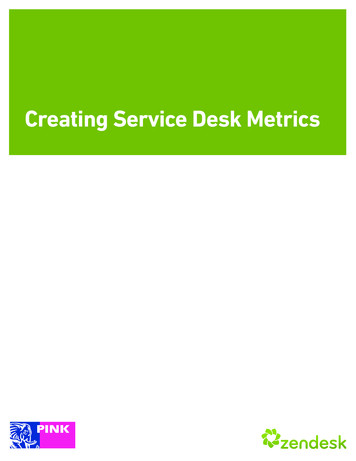
Transcription
Creating Service Desk Metrics
Table of Contents1ITIL, PINK ELEPHANT AND ZENDESK . 32IMPORTANCE OF MONITORING, MEASURING AND REPORTING . 32.1 BALANCED MANAGEMENT INFORMATION CATEGORIES. 32.2 CSFS, KPIS, AND ACTIVITY METRICS. 42.2.1 Key Performance Indicators . 52.3 STEPS FOR CREATING A MEASUREMENT FRAMEWORK . 72.4 METRICS SHOULD DRIVE THE RIGHT BEHAVIOR . 83APPENDIX . 103.13.2SERVICE DESK AND PROCESS METRICS . 10TELEPHONY METRICS . 12Creating Service Desk Metrics Zendesk2
1 ITIL, Pink Elephant and ZendeskITIL (Information Technology Infrastructure Library) is the most widely adoptedframework for IT Service Management in the world. Used by many hundreds oforganizations around the world, a whole ITIL philosophy has grown up around the guidancecontained within the ITIL books and the supporting professional qualification scheme.ITIL Best Practices also underpin the foundations of ISO/IEC 20000 (previously BS15000),the International Service Management Standard for organizational certification andcompliance. Organizations can therefore implement ITIL principles in order to meet therequirements within the standards, to achieve organizational certification.Zendesk facilitates ITIL best practices by helping IT organizations track and measure issueresolution through its native analytics dashboard and enhanced GoodData-poweredbusiness intelligence platform.2 Importance of Monitoring, Measuring and ReportingWe have all heard the saying, “You can’t manage what you don’t measure.” Measurementand verification is often perceived as an overhead or a nice-to-have activity - something wewill eventually get to once the important work is done. For people who are stressed andover-worked, sustaining a best effort often slides downhill into doing the easiest thing.Service Desks metrics span external factors such as impact on customer goals andsatisfaction, and internal factors like goals, critical success factors and key performanceindicators for people, process and technology. Even though Service Desks are often understress and it’s easy to look over measurement importance, it’s critical to remember thatmeasurement is the essential ingredient for feedback, which drives service stateawareness, accountability and improvement to influence management action.2.1 Balanced Management Information CategoriesTimely, accurate, and reliable Management Information is a critical success factor for themanagement and control of the Service Desk. The Service Desk, which can be an internalIT help desk or customer service division, needs to measure each of the following rtnersPerformanceCreating Service Desk Metrics Zendesk3
In fact the first four areas are referenced in the IT Infrastructure Library (ITIL ) bestpractice library as the 4 P’s of value generation and form the building blocks for ensuringcustomer satisfaction. We prefer to think in terms of the 5P’s.The 5Ps all play an important part in Service Desk measurement. UltimatelyCustomer Satisfaction is achieved by managing all of these areas. People – tasks, roles, and responsibilities (for Service Desk Manager andAnalysts, Reporting Analysts, 2nd and 3rd level support groups) defined andassigned to specific personnel. From a metrics perspective, service desk skillsare defined and measured to ensure the right people are in the correct roles. Processes – such as Incident Management and Request Fulfillment define thecore day-to-day activities of Service Desk personnel. The maturity of theprocesses and consistency of execution are key contributors of Service Deskperformance. Products – technical tools that the Service Desk uses such as Zendesk.Zendesk provides ticket and knowledge management, self-help options, portalmessage routing and queuing, as well as a number of integration options withtelephony systems and call bridges, e-mail and status broadcast systems,remote control tools, and more. Zendesk generates analytics and reporting fora number of areas in the 5 P’s. Partners – internal and external suppliers that your organization relies on torun or staff the Service Desk, or to handle incidents and to provision requeststhat are dispatched and managed by the Service Desk. The timeliness andquality of partner services provided to the Service Desk processes are criticalfor establishing and meeting service agreements. Performance – the value provided by the Service Desk to the organization.Standards for timeliness, cost, and customer satisfaction all ground the ServiceDesk relationship with its customers, and the management of the Service Deskas an important function in the organization.2.2 CSFs, KPIs, and Activity MetricsCritical Success Factors (CSFs), Key Performance Indicators (KPIs) and Activity Metrics arecommon measurement terms used when setting up a measurement framework. It isimportant to understand the definition of each and how they relate to each other whenestablishing a measurement system.Critical Success FactorsCreating Service Desk Metrics Zendesk4
At the highest level of a measurement system are the critical success factors (CSFs). A CSFis something that needs to be met or true to achieve your goals. A Process CSF would bethat Service Desk Agents have a defined process that consistently determines the urgencyand impact of a customer issue. For example, when new requests come in, there should bea process in place to assign the request to the correct person or group of people, whoshould then have the knowledge or access to knowledge on how to resolve the request asquickly as possible.Other Service Desk CSFs would include: People: Agents have adequate knowledge of the IT services, technology andorganizations they supportProduct: The ticketing system includes workflows to enable queuemanagement and escalation procedures.Partner: Operational Level Agreements exist for technical and applicationinfrastructure areas to ensure incident resolution intervals for 2nd leveltechnical and application support teams.Performance: Service Desk staff are aware of key performance indicators fortheir roles.Without these critical success factors and others like them in place the achievement ofyour customer services goals are at risk.2.2.1 Key Performance IndicatorsKey Performance Indicators are “chosen“ metrics that measure actual performance todetermine the state of Critical Success Factors. They indicate the health of the ServiceDesk and its components.For example: 80% of Priority 1 Incidents are resolved within 4 hours.Below are some example KPIs for a Service Desk. The numbers are examples only andeach Service Desk will need to define their own KPIs based on organizational goals andobjectives. KPI: First call resolution is at or above 75%KPI: Call abandon rate is maintained at or below 10%KPI: All Severity 1 incident notifications are responded to by 2nd level supportwithin 10 minutesThe set of KPIs for an area should measure the following 4 vectors to ensure a solidunderstanding of the Service Desk performance.Creating Service Desk Metrics Zendesk5
Quantity – A measure that focuses on output. Example: Calls answered,incidents resolved or assigned, requests completed or assigned pershift/day/week/monthQuality – A quality measure focuses on the correctness or accuracy. Example:Notes in logs accurately reflect the history of incidents and requests. 97% of 2ndlevel ticket work queue assignments are correct.Timeliness – A time-based measure. Examples: 80% of Severity 1 Incidents areresolved within 4 hours. 2nd Level acknowledges and responds to Severity 1incidents assigned to their support queues within 10 minutes of notificationsbeing sent.Compliance – Measures that inform controls and governance. Failure to meetcompliance KPIs casts doubt on other measures. (Example: 100% of passwordreset requests include execution and logging of authentication procedures.)Ensure you have a full picture of the health and welfare of your Service Desk. Unless KPIscover all of the four categories of Service Desk management the information provided maynot adequately support decision-making and improvement.Quantity Based Activity MeasuresQuantity measures are important because they provide knowledge on the production of theService Desk. Activity metrics require historical perspective and correlation with externalinformation to inform Service Desk management, capacity and resource planning.Common incident/request management activity metrics include the following in a commoninterval (workday, week, month) Number of new incidents/requests loggedNumber of incidents/requests by priorityNumber of incidents/requests by categoryNumber of incidents/requests by priority and organization unit affectedNumber of incidents/requests resolved/fulfilled by the Service Desk on firstcontactNumber of incidents/requests assigned to 2nd level teamsNumber of incidents/requests resolved/fulfilled by 2nd level teamsNumber of incidents resolved by 3rd level teamsNumber of incidents/requests closedAverage age incidents/requests at closure by categoryNumber of open incidents/requestsAverage age of open incidents/requestsNumber of errors in incident prioritization, categorization, assignment andclosureCreating Service Desk Metrics Zendesk6
It is easy to get caught up in the trap of trying to measure and report on too many quantitybased activity metrics, so each measure chosen should support one or more of the 4 KPIcategories (quantity, quality, timeliness and compliance), which in turn support the CSFs.When starting to collect management information the saying “less is more” often holdstrue. Start small and grow the span of your metrics over time. The key is to ensure thatthere is agreement on what is important to be measured and reported, and thatmanagement is receiving reliable and actionable information.2.3 Steps for Creating a Measurement FrameworkCreating a measurement framework is a series of dependent actions and decisions. Step 1: Understand customer expectation and service requirementsStep 2: Define the Critical Success Factors of the Service Desk 5Ps you aremeasuringStep 3: Choose the KPI Category you are measuring (Quantity, Quality,Timeliness, Compliance)Step 4: Define the KPIStep 5: Define the KPI target or success criteriaStep 6: Determine the data source and instrumentation to obtain and collect KPImeasurementsThe following measurement table provides a visual representation of the relationshipsbetween the CSF, KPIs and Targets.CSFKPICategoryKPI MeasureKPITargetDataElementsIncidents areresolved withintimeframesagreed with thecustomer Quantity Timeliness CompliancePercent ofSeverity 1Incidents in any12 monthperiod areresolved within4 hoursEqual toorgreaterthan80%The majority ofincidents shouldbe resolved bythe ServiceDesk on firstcontact Quantity Quality TimelinessPercent ofIncidentsresolved by theService Deskon first contactin any 2 monthperiodEqual toorgreaterthan75% Customer ID Count ofSeverity 1IncidentRecords Intervallimits Start andResolvedtimestamp foreach Severity1 Incident Count ofIncidentRecords Intervallimits Count ofIncidents withRecipient DataSourceInstrument SLA ReportIntervalDates IncidentSystemsuch asZendesk Zendesk CrystalReports Excel ReportIntervalDates IncidentSystemsuch asZendesk Zendesk CrystalReports ExcelCreating Service Desk Metrics Zendesk7
Customers canreach a ServiceDesk Agentwhen needed Quantity TimelinessCall abandonrate in any 1month periodLessthan10%Resolver Callsreceived Callsabandoned ReportIntervalDates ACDMonthlyReports Excel2.4 Metrics Should Drive the Right BehaviorService Desks usually do a good job of capturing measurements but too often do notanalyze and use the resulting information. Analyzing the measurements is essential fordaily management and identifying improvement opportunities. A part of the analysis is toidentify trends that indicate the Service Desk is improving or reducing its net value to theorganization.As an example, ticket/call volume may have declined for 4 months in a row. At first glance,this may look like an indication of declining demand for the Service Desk. It is hard to tell ifthe conclusion is reasonable, and if the implications are positive or negative.An initial hypothesis could be that the Development team solved some known bugs thatreduced the number of recurring tickets. This could reduce ticket/call volume and if truethe trend is a positive indicator. Now, suppose the Development team informs the ServiceDesk that no such work has been completed recently.Another reasonable hypothesis is that the decline is the result of customers’ frustrationwith poor Service Desk response and the customers simply stopped calling. We can testthat hypothesis with the examination of recent customer survey responses, customerfollow-up calls, and Service Level Review conversations. If information found supports thehypothesis, the Service Desk has a declining service indicator and the Service D
Creating Service Desk Metrics Zendesk 7 It is easy to get caught up in the trap of trying to measure and report on too many quantity based activity metrics, so each measure chosen should support one or more of the 4 KPI
